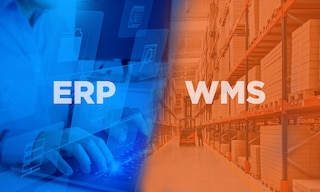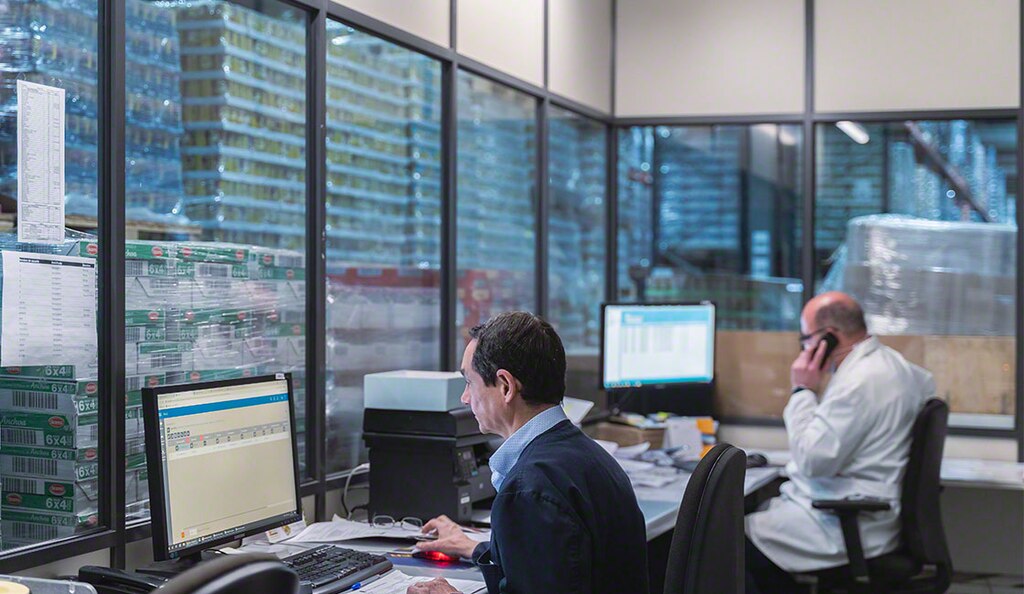
ERP vs. WMS: Which is best for logistics and warehousing?
When dealing with business management, there are several software programs designed to simplify task organization and facilitate coordination and teamwork. The end goal? To increase productivity. Some of the most popular solutions are ERP and WMS.
What is the difference between an ERP and a WMS?
Logistics professionals often face the following dilemma: ERP vs. WMS. To answer this question, it’s important to first understand what each of these programs is:
- Warehouse management system (WMS). This software program oversees a company’s logistics operations. It intervenes in all facility operations, from the receipt of raw materials and finished goods to order shipment. A WMS offers a comprehensive, transparent, real-time view of everything happening at each link of the supply chain.
- Enterprise resource planning (ERP). An ERP system manages and automates an organization’s processes. It consolidates information from various departments and often integrates with other programs such as the WMS or MES (manufacturing execution system).
Therefore, the main difference between an ERP and a WMS is that while the former addresses multiple areas of an organization, the WMS focuses more specifically on warehouse and inventory management.
Which pros and cons do they have?
Both ERP and WMS software have different benefits. Knowing which one will be the best fit for your business depends on your particular circumstances. Numerous companies use both programs jointly to leverage their resources. These are some of their advantages:
| WMS | ERP |
|---|---|
| A WMS increases the productivity and cost-effectiveness of warehouses and logistics centers. | An ERP optimizes the management of an organization’s multiple departments. |
| It automates supply chain processes, from raw materials receipt to omnichannel distribution. | It’s a solution that serves all company areas. |
| Besides coordinating with software like ERP, a WMS offers a rapid return on investment (ROI). | ERPs are easily scalable, integrating with other systems. |
| The best WMSs feature modules to facilitate collaboration with carriers, coordination with production lines, retail inventory management, integration with marketplaces, slotting, automation and robotics, and any other needs a cutting-edge warehouse might have. | An ERP can include modules for purchasing, manufacturing, finance, accounting, warehousing, logistics, and sales areas. These modules are supported by a common database. |
Nevertheless, these solutions can have their drawbacks. The roll-out of an ERP implementation can last several years. Moreover, differences between departments can sometimes mean the tool lacks the necessary flexibility. Some ERPs include warehouse management options; however, they don’t provide a comprehensive enough view of the operations performed in these facilities.
If you’re looking to take control of your supply chain, it’s better to opt for a best of breed WMS that will interface with an ERP and other existing systems in your organization. A prime example is Easy WMS.

Which is better for your warehouse, ERP or WMS?
Both ERPs and WMSs are crucial for supply chain management. So, it’s advisable to ask yourself these questions before choosing between an ERP and a WMS:
- What are your business’s long-term objectives, and how will you measure them?
- What existing processes and systems would have to be integrated with the new ERP or WMS?
- What ROI will the ERP or WMS deliver?
As a rule, although some functionalities of the two programs may overlap, WMS software is specifically designed for intralogistics tasks. Companies operating in this sector — or those simply looking to offload their inventory — need solutions that provide value and coordinate transportation, order management, shipments, and stocktaking.
Aspects to take into account when choosing a WMS
Warehouse management software boosts efficiency and productivity significantly by automating key tasks. Likewise, it monitors inventory levels to avoid stockouts. To know which WMS will best adapt to a logistics center, it’s important to consider several factors.
- Warehouse size. The larger your warehouse, the more advantageous a WMS will be, especially if you need to coordinate multiple facilities and stores. This software can gather data and provide information to all of them simultaneously.
- Product type. WMSs are helpful, but they become essential when working with perishable goods. That is, they ensure that their properties remain intact and prevent them from going to waste.
- IT infrastructure. Some WMSs require the client’s servers, while others run in the cloud via SaaS (software as a service). Easy WMS, for instance, is available in both models.
Manage your warehouse with Easy WMS
Now that you know the differences between an ERP and a WMS, if you’ve realized your business needs the latter, we can help! At Interlake Mecalux, we developed Easy WMS to enhance the throughput of both manual and automated warehouses. Hundreds of clients use it every day to optimize their operations. Easy WMS’s functionalities are vital for your warehouse. Additionally, a team of over 400 engineers dedicated to software development ensures it’s constantly updated. Don’t hesitate to contact us for advice on this and other warehousing solutions.
